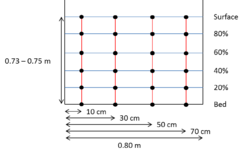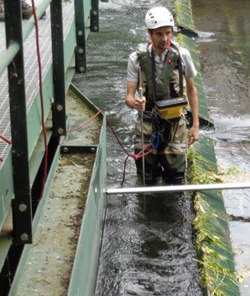Hydropeaking tool
NOTE: fix equations
Contents
Quick summary
Developed by: SINTEF Energy Research
Date: Under development
Type: Tool
Suitable for the following [[::Category:Measures|measures]]:
Introduction
The Hydropeaking Tool is a tool for assessing the impacts of hydropeaking on fish populations in regulated rivers. It is available as an Excel file. The hydropeaking tool is based on a method for assessing impacts from hydropeaking developed for salmonids at SINTEF Energy as a part of the CEDREN EnviPeak project (Norwegian Research Council, Grant number 193818).
The Hydropeaking Tool is currently under development in FitHydro for the Iberian barbel and the grayling, in addition to salmonids. Factors that determine the assessment will be modified or adding for these species. Criteria and thresholds will be adjusted too.
Application
In the Hydropeaking tool, the impacts from hydropeaking are divided into two axis: direct effects from hydropeaking and vulnerability of the fish population to hydropeaking. The effect axis characterises the possible ecological impacts of peaking from how physical conditions such as flow, water level and water covered area changes, given the hydropower system and river morphology. The vulnerability axis characterises how vulnerable the system is to further influence from peaking. Both axis may be evaluated separately, but we also provide a system to combine them and obtain an overall assessment of hydropeaking (Figure 78). The starting point for the evaluation of the current situation is a regulated river without peaking operations.
The current version of the Hydropeaking Tool is available in Excel®. The user has to enter the input values for effects and vulnerability parameters for the studied rivers in the corresponding tables. These input values can be obtained from numerical modelling, analysis of water level/discharge time series, and fieldwork.
The outputs from the Hydropeaking Tool are the score of effects factors, the score of vulnerability factors, and the score for the combined assessment (Figure 79).
The Hydropeaking Tool aims at being used to assess existing or planned hydropeaking. It also gives the user a possibility to see which parameters have a low score, helping to identify where mitigation should be concentrated.
Other information
The Hydropeaking tool will be a deliverable of the FITHydro project.
Relevant literature
- Harby et al., J. 2016. A method to assess impacts from Hydropeaking. Proceedings of 11th International Symposium on Ecohydraulics, Melbourne, Australia.
- Bakken, T.H., Forseth, T and Harby (2016), Miljøvirkninger av effektkjøring: kunnskapsstatus og råd til forvaltning og industri. NINA Special Report 62, Trondheim, Norway.
- Forseth, T and Harby (2014), A. Handbook for environmental design in regulated salmon rivers. NINA Special Report 53, Trondheim, Norway.
- CEDREN www.cedren.no


